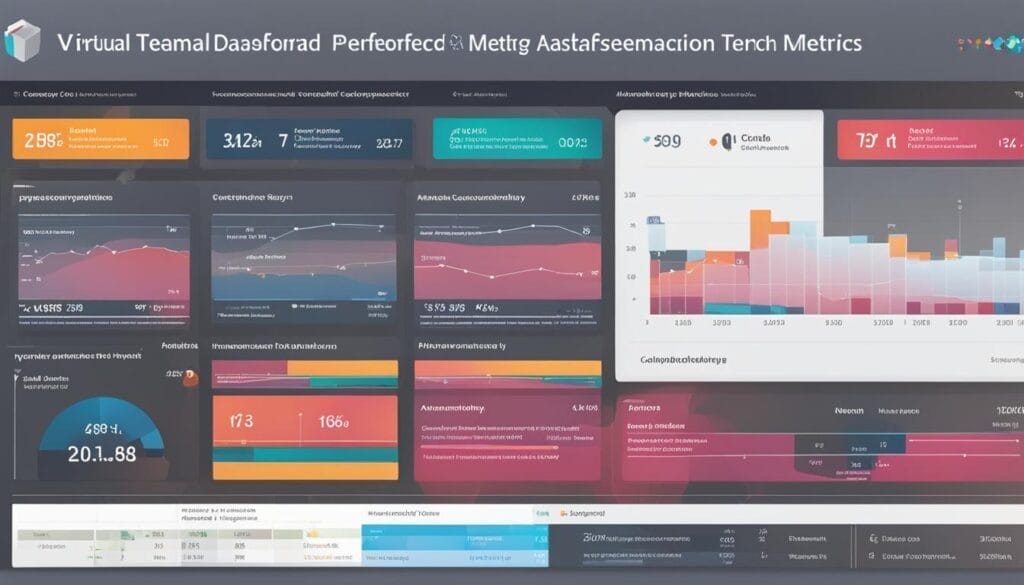Managing a virtual team can be challenging, especially when it comes to measuring and improving their performance and engagement. Effective virtual team leadership is crucial for creating successful remote teams. In this section, we will explore strategies and best practices for enhancing virtual team performance, fostering remote team success, and optimizing virtual team leadership.
Leading virtual teams requires creating a culture of trust, collaboration, and feedback. From setting clear expectations and goals to using the right tools and platforms, every aspect plays a vital role in driving virtual team performance. By implementing these strategies, organizations can create cohesive virtual teams that thrive in a remote work environment.
Key Takeaways:
- Virtual team performance metrics are crucial for measuring and improving remote team success.
- Effective virtual team leadership involves setting clear expectations, fostering collaboration, and providing regular feedback and recognition.
- The right tools and platforms are essential for effective communication, coordination, and collaboration in virtual teams.
- Encouraging learning and development, building trust and rapport, and promoting well-being and balance are key factors in boosting virtual team performance.
- Setting virtual team performance metrics and leveraging technology and tools can help track progress and evaluate success.
Set Clear Expectations and Goals for Virtual Team Success
Communication is key to successful virtual team leadership. To ensure a cohesive and productive virtual team, it is essential to set clear expectations and goals. By defining expectations, deadlines, and quality standards for each project or task, virtual team members have a clear understanding of what is required of them.
SMART goals, which are specific, measurable, achievable, relevant, and time-bound, can be used to track progress and results. These goals provide a framework for evaluating individual and team performance, ensuring that objectives are well-defined and achievable. Using the SMART goal framework helps virtual team members stay focused and motivated.
Another crucial aspect of setting clear expectations and goals is clarifying the roles and responsibilities of each team member. By understanding how their contributions align with the overall vision and mission of the organization, virtual team members can better understand their purpose and work towards shared goals.
Regular virtual team meetings and individual meetings with direct reports play a vital role in setting goals and performance indicators. These meetings provide an opportunity to align objectives, address any challenges, and provide feedback and guidance to team members. By maintaining open lines of communication, virtual team leaders can ensure that everyone is on the same page and working towards a common goal.
Benefits of Setting Clear Expectations and Goals:
- Improved clarity and understanding of project objectives
- Enhanced accountability and ownership among team members
- Increased motivation and focus
- Alignment with the overall vision and mission of the organization
“Setting clear expectations and goals is the foundation of a successful virtual team. By providing a roadmap for success, virtual team leaders empower their team members to deliver their best work and achieve remarkable results.” – Jane Smith, Virtual Team Manager
By setting clear expectations and goals, virtual team leaders lay the groundwork for success. With a shared understanding of what needs to be accomplished and how each team member contributes to the overall vision, virtual teams can overcome challenges and achieve their objectives.
Key Elements for Setting Clear Expectations and Goals
| Element | Description |
|---|---|
| Clear Communication | Establish open and effective channels of communication to ensure understanding and alignment. |
| SMART Goals | Create specific, measurable, achievable, relevant, and time-bound goals to track progress. |
| Role Clarity | Clearly define the roles and responsibilities of each team member to ensure everyone knows their contributions. |
| Regular Meetings | Conduct virtual team meetings and individual meetings to discuss progress, address challenges, and provide feedback. |
Use the Right Tools and Platforms for Effective Collaboration
Virtual team leadership requires the use of the right tools and platforms to facilitate seamless communication, collaboration, and coordination. By leveraging technology, virtual teams can overcome geographical barriers and work together efficiently towards a common goal.
Here are some essential tools and platforms that can enhance virtual team collaboration:
1. Video Conferencing
Tools like Zoom and Skype allow virtual team members to connect face-to-face through high-quality video calls. Video conferencing facilitates real-time communication, encourages active participation, and helps build stronger relationships among team members.
2. Instant Messaging
For quick updates and informal discussions, instant messaging platforms such as Slack and Microsoft Teams offer a convenient and efficient way for virtual teams to communicate. Chat channels can be created for different projects or teams, ensuring smooth and organized communication.
3. File Sharing
Sharing files and collaborating on documents is essential for virtual teams. Platforms like Google Drive and Dropbox provide secure and centralized spaces where team members can upload, share, and collaborate on files in real-time.
4. Project Management
Effective project management tools like Asana and Trello help virtual teams organize and prioritize tasks, set deadlines, assign responsibilities, and track progress. These platforms enable transparent project management, ensuring that everyone is on the same page and tasks are completed efficiently.
5. Performance Management
To set goals, provide feedback, and track individual and team performance, tools like Lattice and 15Five can be beneficial. These platforms offer features such as goal-setting, performance reviews, and continuous feedback, fostering a culture of accountability, growth, and improvement.
Using the right tools and platforms can streamline virtual team collaboration, enhance communication, and promote effective coordination. By leveraging these technologies, virtual team leaders can create a productive and cohesive working environment, where team members can collaborate seamlessly towards shared objectives.
| Tool/Platform | Features |
|---|---|
| Video Conferencing (e.g., Zoom, Skype) | High-quality video calls, screen sharing, virtual backgrounds |
| Instant Messaging (e.g., Slack, Microsoft Teams) | Real-time chat, file sharing, channel-based communication |
| File Sharing (e.g., Google Drive, Dropbox) | Secure file storage, real-time collaboration on documents |
| Project Management (e.g., Asana, Trello) | Task organization, deadline management, progress tracking |
| Performance Management (e.g., Lattice, 15Five) | Goal-setting, performance reviews, continuous feedback |
Provide Regular Feedback and Recognition
Feedback and recognition play a crucial role in boosting virtual team performance and engagement. Whether it’s acknowledging a job well done or providing constructive feedback for improvement, regular feedback fosters a culture of continuous learning and growth within the team.
When it comes to feedback, both positive and constructive, virtual leaders have the opportunity to provide guidance and support to their team members. Positive feedback reinforces desired behaviors and motivates virtual team members to excel in their roles, while constructive feedback helps them understand areas for improvement and develop professionally.
Formal methods, such as performance reviews or 360-degree feedback, offer structured frameworks for feedback discussions and evaluations. These processes allow virtual leaders to assess team members’ performance and provide valuable insights for growth. Additionally, formal feedback methods create a sense of fairness and transparency within the team.
On the other hand, informal feedback methodologies, such as emails, chats, or shout-outs, provide a more casual and immediate approach to recognition and feedback. These informal channels allow virtual leaders to provide timely and specific feedback, reinforcing positive behaviors in real-time.
Positive feedback examples:
- Recognizing an individual team member’s exceptional contribution to a project.
- Expressing appreciation for a team member’s collaboration and support.
- Highlighting a team member’s creativity and problem-solving skills.
Constructive feedback examples:
- Providing guidance on improving time management skills for better productivity.
- Offering suggestions for enhancing communication and collaboration within the team.
- Giving feedback on areas of improvement to enhance the quality of work.
“Feedback is the breakfast of champions.” – Ken Blanchard
Recognition is another important aspect of boosting virtual team performance. Celebrating team members’ successes and milestones reinforces their value to the team and organization. Recognition can take various forms, such as public announcements, team-wide emails, or virtual celebrations.
Providing regular feedback and recognition not only enhances individual performance but also strengthens team cohesion and morale. It fosters a positive work culture where team members feel valued and motivated to contribute their best. By implementing effective feedback and recognition strategies, virtual leaders can drive virtual team performance to new heights.
| Benefits of Regular Feedback and Recognition | Impact on Virtual Team Performance |
|---|---|
| Boosts motivation and engagement | Increases productivity and quality of work |
| Enhances individual and team performance | Promotes collaboration and teamwork |
| Fosters a culture of continuous learning and improvement | Reduces turnover and improves retention |
| Builds trust and rapport within the team | Boosts morale and job satisfaction |
Encourage Learning and Development in Virtual Teams
In order to enhance the skills and competencies of virtual team members, it is crucial to encourage learning and development within the team. By providing access to relevant and engaging resources, virtual team members can continually grow and improve their performance. This section highlights the importance of learning and development in virtual teams and offers strategies to support career growth and foster a culture of knowledge sharing.
Access to Relevant and Engaging Resources
Providing virtual team members with access to a wide range of learning resources is key to their professional development. Offer online courses, webinars, podcasts, and articles that are tailored to their specific roles and responsibilities. By offering resources that are relevant and engaging, virtual team members can acquire new knowledge and skills that directly contribute to their performance and success.
Career Growth Opportunities
In addition to learning resources, virtual team members should be provided with opportunities for career growth. This can be done through mentoring, coaching, or sponsorship programs, which offer guidance and support for their career advancement. By investing in their professional development, virtual team members will feel valued and motivated, leading to improved performance and job satisfaction.
Culture of Knowledge Sharing
Encouraging virtual team members to learn from each other is a powerful way to foster a culture of knowledge sharing. By creating forums or online platforms for collaboration and peer feedback, team members can exchange ideas, best practices, and lessons learned. This not only enhances individual learning but also contributes to the collective knowledge and expertise of the entire virtual team.
By prioritizing learning and development, virtual teams can continuously enhance their performance and achieve their goals. Providing virtual team members with access to relevant resources, offering career growth opportunities, and fostering a culture of knowledge sharing are all essential components of a high-performing virtual team.
In the next section, we will explore the importance of building trust and rapport within virtual teams to further enhance their performance and collaboration.
Build Trust and Rapport in Virtual Teams
Trust and rapport are crucial for achieving virtual team performance and fostering a positive work environment. When working remotely, it is essential to establish clear channels of communication and build strong relationships among team members. Here are some strategies to build trust and rapport in virtual teams:
1. Transparent Communication: Foster a culture of transparency by ensuring open and honest communication. Clearly communicate expectations, goals, and project updates. Encourage team members to ask questions and voice concerns.
2. Empathy and Respect: Show empathy and respect for the challenges and experiences of your virtual team members. Understand their unique situations and accommodate their needs as much as possible. Encourage empathy and understanding among team members as well.
3. Virtual Coffee Breaks: Create opportunities for social interaction and bonding through virtual coffee breaks. Schedule regular time for team members to come together and connect on a more personal level. This can contribute to building trust and rapport.
Virtual coffee breaks not only provide a chance for team members to relax and recharge but also foster connections and strengthen relationships. These informal interactions can lead to increased camaraderie and collaboration.
4. Recognition and Appreciation: Acknowledge and appreciate the efforts and achievements of your virtual team members. Recognize and celebrate individual and team successes. This can foster a sense of belonging and motivation within the team.
5. Team Building Activities: Organize virtual team-building activities or events to promote social interaction and enhance rapport. This can include virtual games, quizzes, or group discussions on non-work-related topics. Encourage participation and create a sense of unity within the team.
By implementing these strategies, virtual team leaders can build trust and rapport, improving collaboration, communication, and ultimately, virtual team performance.
Promote Well-being and Balance in Virtual Teams

In order to ensure sustained virtual team performance, it is crucial to prioritize the well-being and work-life balance of team members. By promoting a healthy and balanced work environment, virtual teams can thrive and achieve optimal results. Here are some strategies to promote well-being and balance in virtual teams:
- Set realistic expectations and boundaries: Establish clear guidelines regarding work hours, deadlines, and availability. Encourage team members to communicate their boundaries and respect each other’s personal time.
- Encourage breaks and exercise: Remind team members about the importance of taking regular breaks to rest and recharge. Encourage them to engage in physical activities or exercises to reduce stress and promote well-being.
- Practice self-care: Encourage team members to prioritize self-care activities that contribute to their personal well-being. This can include activities such as meditation, deep breathing exercises, or engaging in hobbies outside of work.
- Provide support and resources: Ensure that team members have access to resources and support systems that can help them cope with work-related challenges. This can include providing access to mental health resources, counseling services, or employee assistance programs.
- Regular check-ins: Maintain open lines of communication with team members and regularly check in to see how they are doing. Encourage them to share any concerns or difficulties they may be facing and offer support and guidance as needed.
Remember, a well-balanced and supported virtual team is more likely to achieve higher performance levels and overall success.
By prioritizing well-being and work-life integration, virtual teams can create a positive and supportive work environment that enhances performance and engagement. Let’s continue exploring strategies to boost virtual team performance in the next section.
Set Virtual Team Performance Metrics to Track Progress
Setting virtual team performance metrics is essential for tracking progress and evaluating success. By determining key performance indicators (KPIs) that align with organizational goals, you can effectively measure and improve team performance. These metrics provide a clear understanding of how well the team is functioning and contribute to achieving desired outcomes.
Key performance indicators for virtual teams can include:
- Individual and team goals
- Productivity
- Quality of work
- Customer satisfaction
Tracking these metrics on an ongoing basis allows you to measure progress and identify areas for improvement. Additionally, it provides insights into the effectiveness of your virtual team’s processes and helps you make data-driven decisions to optimize performance.
Monitoring virtual team performance metrics can be done through various methods, including regular check-ins, performance assessments, and the use of technology and tools. It’s crucial to establish a system that captures relevant data consistently and accurately, enabling you to measure progress and results effectively.
| Virtual Team Performance Metrics | Description |
|---|---|
| Individual and Team Goals | Measures the extent to which individual and team goals are being achieved. |
| Productivity | Quantifies the level of output and efficiency in completing tasks and projects. |
| Quality of Work | Evaluates the accuracy, thoroughness, and excellence of the team’s deliverables. |
| Customer Satisfaction | Gauges the level of satisfaction and loyalty among customers or clients. |
Using these metrics, you can gain valuable insights into the overall performance of your virtual team. You can identify strengths and areas for improvement, and take proactive steps to address any challenges. Regularly reviewing and analyzing these performance metrics allows you to optimize team performance, enhance collaboration, and achieve the desired outcomes for your virtual team.
Use Technology and Tools to Measure Virtual Team Performance

Technology and tools play a crucial role in measuring virtual team performance metrics. By leveraging the right tracking software and platforms, team leaders can obtain real-time insights into various performance indicators. These metrics include productivity, task completion, meeting attendance, and responsiveness.
Tracking software such as Toggl Track provides an efficient way to monitor virtual team performance metrics. It allows leaders to precisely track the time spent on different tasks, ensuring optimal productivity and efficient resource allocation. Additionally, project management tools like Asana and communication platforms like Slack offer valuable features for overseeing virtual team performance.
“Measuring virtual team performance metrics is not just about gathering data; it empowers team leaders to make data-driven decisions that can improve team dynamics and overall productivity.”
Monitoring and Reporting on Engagement Metrics
Engagement metrics are crucial for assessing virtual team performance. These metrics provide insights into the team’s level of collaboration, communication, and overall cohesion. Tools like Asana and Slack offer features that enable leaders to monitor and report on these engagement metrics.
Asana, a popular project management tool, allows team leaders to track task and project progress. It provides a comprehensive overview of how team members are actively contributing and collaborating. On the other hand, Slack’s user-friendly interface and customizable channels facilitate seamless communication, promoting engagement and productive conversations within virtual teams.
Visualizing Virtual Team Performance Metrics
Visualizing virtual team performance metrics can help leaders identify trends, patterns, and areas for improvement. Clear and concise visual presentations enable easy interpretation and analysis. Creating visually appealing charts and graphs based on data collected from tracking software and collaboration platforms can provide valuable insights.
Here is an example of how virtual team performance metrics can be visualized:
| Metric | Measure |
|---|---|
| Productivity | Number of completed tasks per team member |
| Meeting Attendance | Percentage of attended meetings per team member |
| Responsiveness | Average response time to team communication |
By visualizing and analyzing these metrics, team leaders can gain a comprehensive understanding of virtual team performance and make informed decisions to enhance collaboration and productivity.
Implementing technology and utilizing appropriate tools can significantly contribute to measuring and improving virtual team performance. By effectively monitoring metrics, leaders can make data-driven decisions, address potential challenges, and optimize team performance for success.
Foster Motivation and Engagement in Virtual Teams
Motivation and engagement are key drivers of success for virtual teams. By creating an environment that fosters motivation and engagement, you can boost productivity and build a cohesive virtual team. Here are some strategies to help you foster motivation and engagement in your virtual team:
- Conduct surveys and collect feedback: Regularly conduct surveys and gather feedback from your team members to understand their motivation levels and needs. This will help you identify areas where improvements can be made and implement strategies to address any challenges.
- Provide recognition and rewards: Recognize and reward your virtual team members for their achievements and contributions. This can be done through virtual team meetings, emails, or shout-outs. Acknowledging their hard work and efforts will boost morale and motivation.
- Foster a culture of gamification and fun: Infuse a sense of gamification and fun in your virtual team. This can be done through virtual team-building activities, competitions, or challenges. Encouraging friendly competition and creating a positive and enjoyable work environment will increase engagement and motivation.
Creating a motivated and engaged virtual team requires ongoing effort and communication. By implementing these strategies, you can create a positive work environment that inspires your virtual team to perform at their best.
“Engaged virtual teams exhibit higher levels of productivity, satisfaction, and innovation. By fostering motivation and engagement, you can create a virtual team that excels in their work and achieves exceptional results.”
| Benefits of Motivated and Engaged Virtual Teams |
|---|
| Increased productivity |
| Higher job satisfaction |
| Enhanced problem-solving and innovation |
| Improved collaboration and communication |
| Lower turnover rates |
Overcome Challenges and Improve Virtual Team Performance
Overcoming challenges and continuously improving virtual team performance is crucial for achieving optimal results. By leveraging performance metrics and feedback data, teams can identify areas that require improvement and implement effective strategies to address them.
One common challenge faced by virtual teams is communication. Ensuring clear and effective communication channels are in place is vital for seamless collaboration. Whether it’s addressing time zone differences, language barriers, or technological hiccups, addressing communication challenges promptly and proactively can significantly enhance team performance.
Another pivotal aspect of improving virtual team performance is providing additional training and resources. Equipping team members with the necessary skills and knowledge can empower them to excel in their roles. This could involve providing training sessions, access to learning platforms, or mentorship opportunities.
“Building trust and rapport in virtual teams can be challenging, but it is essential for fostering strong relationships and driving performance.”
Building trust and rapport is another critical factor for virtual team success. When team members trust each other, they are more likely to collaborate effectively and achieve shared goals. Encouraging virtual team members to connect on a personal level through icebreakers or virtual coffee breaks can help foster relationships and build trust.
Regular data analysis is fundamental to improving virtual team performance. By collecting and analyzing performance metrics, teams gain insights into their strengths and weaknesses. These insights can drive informed decision-making and enable teams to develop targeted improvement strategies.
“The success of virtual teams relies on the ability to adapt and iterate based on data-driven insights.”
| Virtual Team Challenges | Improvement Strategies |
|---|---|
| Communication barriers | Implement communication tools, address time zone differences, promote clear communication guidelines |
| Lack of trust and rapport | Encourage virtual team bonding activities, foster open and transparent communication, establish regular check-ins |
| Technology-related issues | Provide training and support for virtual tools, troubleshoot technical problems promptly |
| Performance measurement | Set clear performance metrics and goals, track progress using data-driven insights, provide regular feedback |
By addressing these challenges and implementing effective improvement strategies, virtual teams can enhance their overall performance and achieve greater success.
Conclusion
Boosting virtual team performance metrics and achieving remote team success requires a combination of effective leadership, clear communication, and the right tools and platforms. Regular feedback and recognition, along with a focus on learning and development, trust and rapport, as well as well-being and balance, are also crucial for creating cohesive virtual teams.
By implementing these strategies, virtual teams can enhance their efficiency and productivity, foster stronger collaboration and engagement, and ultimately achieve their goals. Effective leadership establishes clear expectations and goals, while clear communication ensures that team members stay connected and aligned.
The use of appropriate tools and platforms facilitates effective collaboration, coordination, and performance management. Regular feedback and recognition provide motivation and boost team morale. Encouraging continuous learning and development enables team members to enhance their skills and contribute more effectively. Building trust and rapport fosters a positive team dynamic and a sense of camaraderie.
Promoting well-being and balance ensures that virtual team members can maintain their productivity and satisfaction over the long term. By prioritizing these elements, virtual teams can improve their performance, boost their productivity, and achieve success even in a remote and distributed work environment.
FAQ
What are some strategies for boosting virtual team performance metrics?
Some strategies for boosting virtual team performance metrics include setting clear expectations and goals, using the right tools and platforms, providing regular feedback and recognition, encouraging learning and development, building trust and rapport, and promoting well-being and balance.
How can I set clear expectations and goals for my virtual team?
To set clear expectations and goals for your virtual team, you can define SMART goals (specific, measurable, achievable, relevant, and time-bound), clarify roles and responsibilities, and hold regular virtual team meetings and individual meetings with direct reports to set goals and performance indicators.
What tools and platforms should I use for effective collaboration with my virtual team?
Some tools and platforms that can be used for effective collaboration with your virtual team include video conferencing tools like Zoom or Skype, instant messaging platforms like Slack or Teams, file sharing platforms like Google Drive or Dropbox, and project management and performance management tools like Asana, Trello, Lattice, or 15Five.
How can I provide regular feedback and recognition to my virtual team?
You can provide regular feedback and recognition to your virtual team through formal methods like performance reviews or 360-degree feedback, as well as informal methods like emails, chats, or shout-outs. Recognize and reward team members for their contributions and celebrate their successes and milestones.
How can I encourage learning and development in my virtual team?
To encourage learning and development in your virtual team, you can provide access to relevant learning resources such as online courses, webinars, podcasts, or articles. Support career growth and offer mentoring, coaching, or sponsorship opportunities. Foster a culture of knowledge sharing and peer feedback.
How can I build trust and rapport in my virtual team?
To build trust and rapport in your virtual team, you can be transparent, honest, and consistent in your communication and actions. Show empathy, respect, and appreciation for team members. Create opportunities for social interaction and bonding, such as virtual coffee breaks, happy hours, or team-building activities.
What can I do to promote well-being and balance in my virtual team?
To promote well-being and balance in your virtual team, you can set realistic expectations and boundaries, encourage team members to take breaks, exercise, and practice self-care. Provide support and resources to help them cope with challenges. Regularly check in with team members to see how they are doing.
How do I set virtual team performance metrics to track progress?
To set virtual team performance metrics to track progress, determine key performance indicators (KPIs) that align with organizational goals and measure team performance. These metrics can include individual and team goals, productivity, quality of work, and customer satisfaction.
What technology and tools can I use to measure virtual team performance?
You can use tracking software like Toggl Track, Asana, or Slack to monitor virtual team performance metrics in real-time, including productivity, task completion, meeting attendance, and responsiveness. These tools can aid in monitoring and reporting on engagement metrics.
How can I foster motivation and engagement in my virtual team?
To foster motivation and engagement in your virtual team, you can conduct surveys and collect feedback from team members to understand their motivation levels and needs. Provide recognition and rewards for achievements and contributions. Foster a culture of gamification and fun to make work enjoyable and engaging.
How can I overcome challenges and improve virtual team performance?
To overcome challenges and improve virtual team performance, use the data from performance metrics and feedback to identify areas for improvement. Address communication or technology challenges, provide additional training or resources, and adapt strategies based on the needs of the team.





